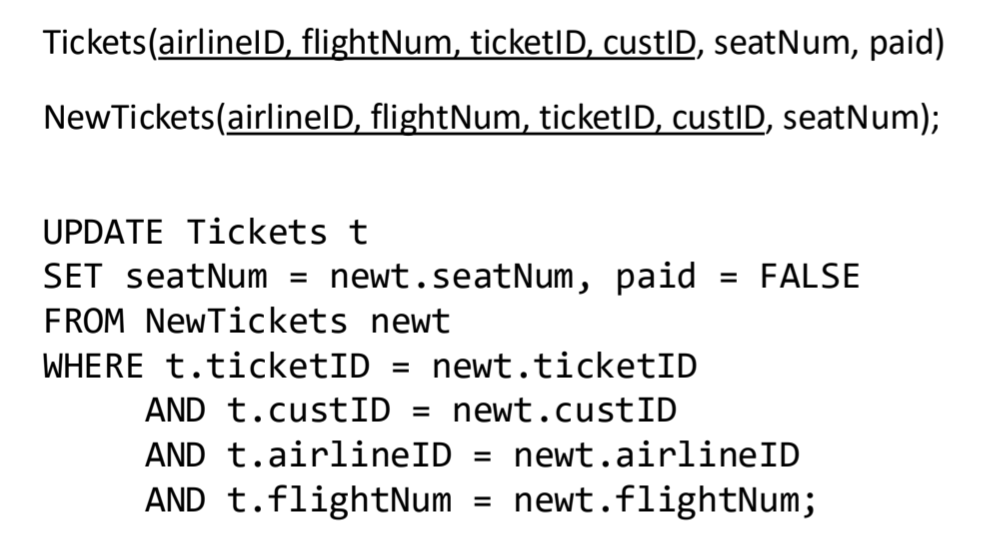SQL - DML
1/41
There's no tags or description
Looks like no tags are added yet.
Name | Mastery | Learn | Test | Matching | Spaced |
|---|
No study sessions yet.
42 Terms
4 operations on data
Create = INSERT
Read = SELEECT
Update = UPDATE
Delete = DELETE
Different than drop since you’re just deleting a few tuples and not the entrire database
Organization of Query
SELECT c1, c2, .., cm (attrs names)
FROM R1, R2, .., Rn (relation names)
WHERE condition
ORDER BY list of attrs
GROUP BY
execution order: FROM → WHERE → SELECT
SELECT
SELECT * - returns all cols
SELECT x, y - only returns these cols
Can have simple expressions: SELECT length * 60 AS durationInSec
Can have constants: SELECT ‘secs’ as unit (will create a new col called unit and will have secs in each row for that)
DISTINCT
doesn’t allow duplication
SELECT DISTINCT attr
Aliasing attrs
rename attrs of the result
SELECT movieTitle as name
SELECT movieTitle name
WHERE
conditional expressions combined using logical operations (AND, OR, NOT)
conditional expressions: output a BOOLEAN value (TRUE, FALSE, UNKNOWN) using comparion operations (<>, LIKE, || (string concantation), =, <, +, -)
LIKE - String Comparison: Pattern Matching
Like allows you to use 2 patterns:
% (0+ chars)
_ (1 char)
string LIKE pattern
Ex.
WHERE movieTitle LIKE ‘Toy%’ (can be Toy Story 2, Toy Story, Toy)
Strings: quotes
LIKE puts patterns in: ‘‘
single quote in SQL: ‘‘
match a single quote symbol (‘): WHERE movieTitle LIKE ''''
two quote symbols (‘‘): WHERE movieTitle LIKE ''''''
match % or _: using ESCAPE character
ESCAPE
ESCAPE ‘!’ means that putting ‘!’ before special characters make them a string
can be any character: s LIKE ‘x%%x%’ ESCAPE x makes x into the escape — it means any string that starts or end with % since only the middle % has its any string interpretation
NULL
special value
any arithmetic operation involving a NULL results in a NULL
comparison involving NULL results in an UNKNOWN
Logical operations wtih T, F, and U
True = 1, False = 0, Unknown = 0.5
p OR q = MAX(p,q)
p AND q = MIN(p,q)
NOT p = 1 -p
If the condition evaluates to UNKNOWN, then the tuple will not be returned.
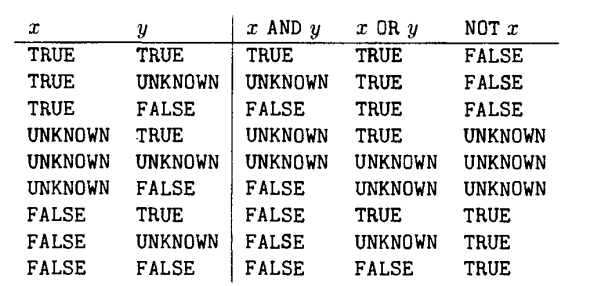
NULL, UNKNWON, and EMPTY SET
attrs can be NULL
results of a condition can be UNKNOWN
results of a query can be Empty Set
ORDER BY
presents the result in a sorted order, by default it’s ascending
ORDER BY x
ORDER BY x ASC, y DESC
can be expressions: ORDER BY quantity * price DESC
can be NULL: NULL is either the smallest/largest values and will be specificed in exams
Joining multiple tables
FROM R1, R2
Cartesian product (CROSS JOIN).
Same as: FROM R1 CROSS JOIN R2 (nobody uses it)
FROM R1 r1, R2 r2 (self join)
FROM R1 JOIN R2 ON attr1 = attr2
For when two cols has the same behavior but different names, usually on a primary key to foreign key
FROM R1 INNER JOIN R2
FROM R1 NATURAL JOIN R2
FROM R1 FULL OUTER JOIN R2
FROM R1 LEFT OUTER JOIN R2
FROM R1 RIGHT OUTER JOIN R2
Disambiguating Attrs
use relation name in attrs that exist in both tables: R1.name
Cross Join ex:
SELECT name
FROM Movies, MovieExec
WHERE title = ‘Jurassic Park’ AND directorC# = cert#;
Compute Cartesian product of the tables in FROM
Filter tuples that evaluate TRUE for the WHERE clause
Evaluate the SELECT clause
FOR each tuple t1 in Movies
FOR each tuple t2 in MovieExec
IF the WHERE-clause is satisfied when the values from t1, t2 are
substituted
Evaluate the SELECT-clause and produce the tuple of values
that results.
Inner Join
Natural Join
The join condition is that all pairs of attributes from the two relations having a common name are equated, and there are no other conditions.
One of each pair of equated attributes is projected out
Full Outer Join
Includes all rows from both tables, with NULL where there is no match.
keyword OUTER is optional

Left Outer Join
All rows from the left table and the matching rows from the
right table
If there’s no match, the right-side columns will have NULL.
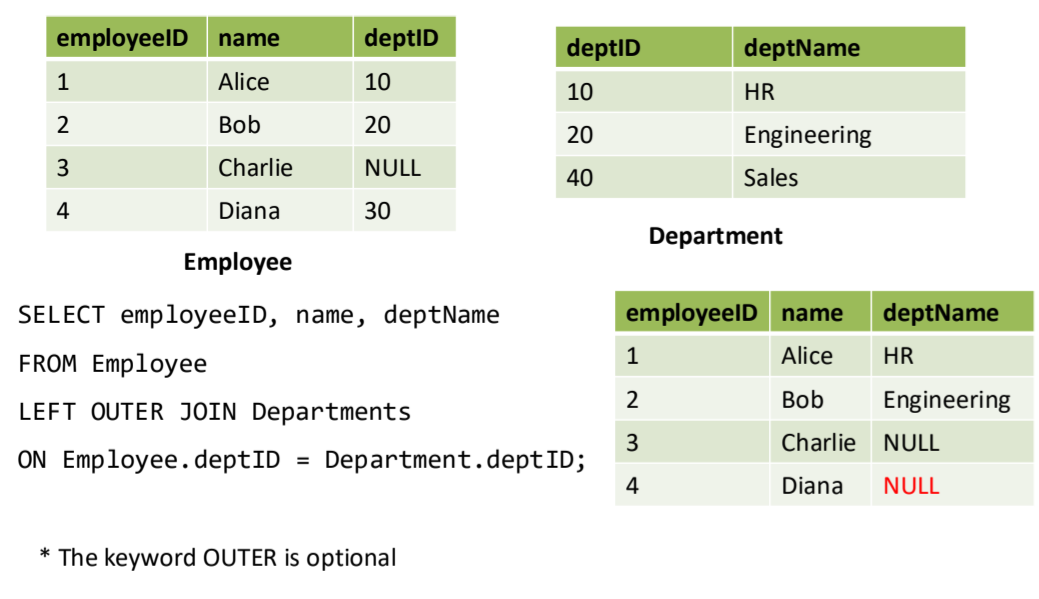
Right Outer Join
All rows from the right table and the matching rows from the
left table
If there’s no match, the left-side columns will have NULL.
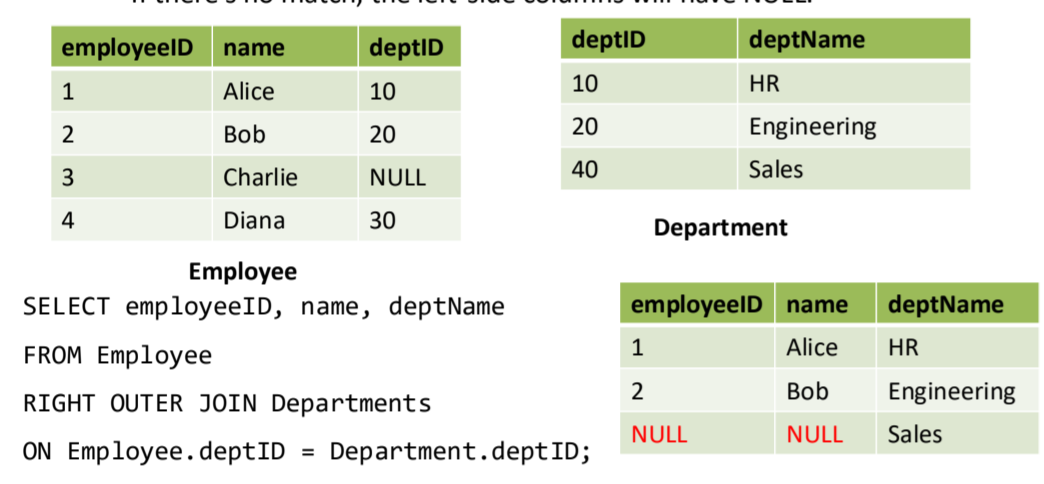
Comparison Operators
x IN Q
– Returns true if x occurs in the collection Q.
x NOT IN Q
– Returns true if x does not occur in the collection Q.
x > ANY Q
– Returns TRUE if x is greater than at least one value in Q. – Can also use >=, <, <=, =, <>
x > ALL Q
– Returns TRUE if x is greater than every value in Q. – Can also use >=, <, <=, =, <>
EXISTS Q
– Returns true if Q is a non-empty collection.
NOT EXISTS Q
– Returns true if Q is an empty collection.
Subquery
a query that is embedded in another query.
can return a constant (scalar value) which can be compared against another constant in the WHERE clause
can also return a relation and used as a Collection in the WHERE Clause
A subquery returning a relation can appear in the FROM clause
Subquery EX
SELECT name
FROM MovieExec
WHERE cert# IN
(SELECT directorC#
FROM Movies
WHERE movieTitle = ‘Jurassic Park’);
2)
SELECT e.name
FROM MovieExec e,
(SELECT m.directorC#
FROM Movies m
WHERE m.movieTitle = ‘Jurassic Park’) p WHERE e.cert# = p. directorC # ;
Set vs Bag
Set: no dumplicated
Bag: duplicates allowed
relations are a bag of tuples
Set and Bag Operations
Used between two subqueries which will result in a relation
Set operations (UNION, INTERSECT, EXCEPT)
Bag operations (UNION ALL, INTERSECT ALL, EXCEPT ALL)
Set Operation Descriptions
Union = OR
Intersect = AND
Except = NOT
Bag Operation Descriptions
if there are m copies of x in R and n copies of x in R2
Union → total (m+n) copies
Intersect: → total MIN(m, n) copies
Except → total MAX(m-n, 0) copies
Set UNION
All people either a movie executive Pa female movie star
(SELECT name, address
FROM MovieStar
WHERE gender = ‘F’)
UNION
(SELECT name, address
FROM MovieExec)
Set INTERSECT
people who are both movie star and executive
(SELECT name, address
FROM MovieStar )
INTERSECT
(SELECT name, address
FROM MovieExec);
Set EXCEPT
Movie stars who are not executives
(SELECT name, address
FROM MovieStar)
EXCEPT
(SELECT name, address
FROM MovieExec)
5 aggregation operations
SUM, AVG, MIN, MAX, COUNT
Aggergation
Specified in SELECT
applied on attrs
except COUNT(*) which counts the number of tuples in the table
ignores NULL (unless it’s COUNT(*))
Aggregation Example
SELECT COUNT(name) FROM Employee;
SELECT SUM(salary) FROM Employee;
SELECT COUNT(name), COUNT(DISTINCT deptName) FROM Employee;
Second lowest salary
SELECT MIN(e.salary)
FROM Employee eWHERE e.salary >
(SELECT MIN(salary) FROM Employee);
GROUP BY
comes after WHERE
one row per group
NULL is used and counts as a group
usually aggregation is used within each group
in SELECT clause with aggregations, only attrs in the GROUP BY can appear unaggregated
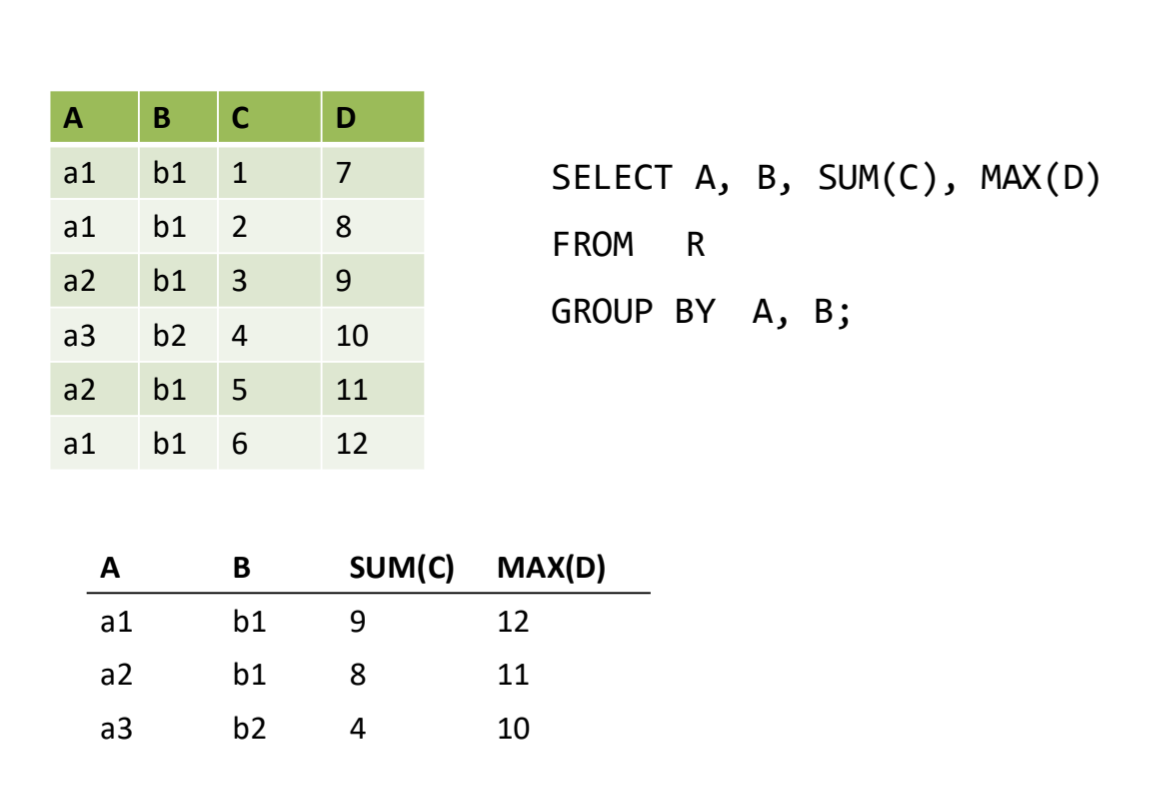
HAVING Clause
like a WHERE clause applied to groups
cant exist without GROUP BY
Only those attributes that are in the GROUP BY list may appear unaggregated in the HAVING clause
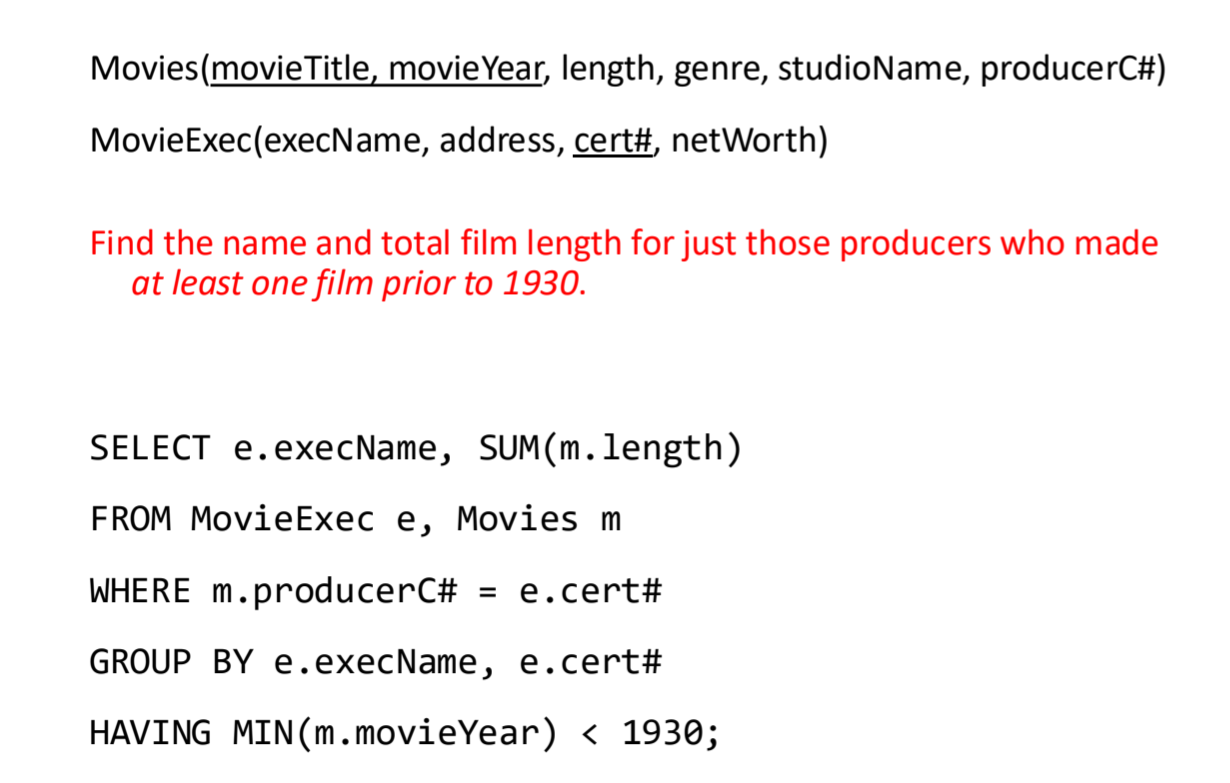
INSERT Statements with Values
A tuple (v1 , …, vn ) is inserted into the relation R, where attribute A = v iand default values are entered for all missing attributes.
INSERT INTO R(A 1 , …, A n )
VALUES (v 1 , …, v n );The tuple ('The Maltese Falcon', 1942, 'Sydney Greenstreet') will be added to the relation StarsIn.
StarsIn(movieTitle, movieYear, starName)
INSERT INTO StarsIn(movieTitle, movieYear, starName)
VALUES ('The Maltese Falcon', 1942, 'Sydney Greenstreet');can be a subquery:
INSERT INTO Studio(studioName)
SELECT DISTINCT m.studioName
FROM Movies m
WHERE m.studioName NOT IN
(SELECT st.studioName
FROM Studio st)DELETE
DELETE FROM R
WHERE <condition>;
The tuple ('The Maltese Falcon', 1942, 'Sydney Greenstreet') will be deleted from the relation StarsIn.
DELETE FROM StarsIn
WHERE movieTitle = 'The Maltese Falcon'
AND movieYear = 1942
AND starName = 'Sydney Greenstreet';
we cannot simply specify a tuple to be deleted. Rather, we must describe the tuple exactly by a WHERE clause.
UPDATE syntax
UPDATE R
SET <new-value-assignments>
WHERE <condition>;
<new-value-assignment> :<attribute> = <expression>, …, <attribute> = <expression>
Ex:
UPDATE Employee
SET salary = 9000
WHERE name = ‘Bob';
Ex. with subquery: attaching the title Pres. in front of the name of every movie executive who is the president of a studio:
UPDATE MovieExec
SET execName = 'Pres. ' || execName
WHERE cert# IN ( SELECT presC# FROM Studio );
UPDATE with FROM
The UPDATE clause specifies the table being updated (just one table).
UPDATE statement can also have a FROM clause.
The UPDATE statement's WHERE clause can refer to both the updated
table and the table(s) in the FROM clause
